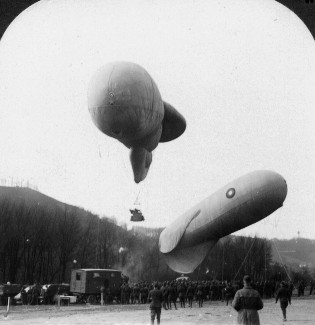The Parachute
Today, we fall safely out of the sky. The University of Houston's College of Engineering presents this series about the machines that make our civilization run, and the people whose ingenuity created them.
By WW-I, parachutes were a pretty well developed technology. Of course, they weren't given to fighter pilots. That was because they were still pretty bulky, but it was also because some people felt they'd have a bad effect on the morale and courage of pilots. On the other hand, the lookouts who manned front-line observation blimps were given parachutes, and they made heavy use of them. Those blimps were shot down with tedious regularity.
The parachute was actually around for hundreds of years before the airplane was invented. The first well-documented parachute drop was made by the Frenchman Lenormand, who jumped from a tower in 1783. And it was also Lenormand who invented the word parachute. It literally means something that opposes falling. The usual accounts credit Leonardo da Vinci with the idea because he included a pyramidal cloth parachute in a one of his sketchbooks in 1485.
But historian Lynn White has discovered an anonymous set of Renaissance Italian manuscripts on technology that he can date to about 1470 -- 15 years ahead of Leonardo. These include two sketches of parachutes. One shows a brace of long cloth streamers that clearly could've broken a fall. The other shows a parachute that's very similar to Leonardo's -- conical in shape instead of pyramidal, but identical in all its other features.
White asks how the idea got from this author to Leonardo. It's unlikely that Leonardo actually saw the manuscript, because there were no patent laws in those days, and people tended to be awfully secretive about their writings. But Renaissance engineers had what White calls "an intensely oral tradition." A great deal of information was passed by conversation, and the idea of the parachute was -- as he wryly puts it -- "in the air" during the Renaissance.
And who made the first jump? Well, that seems to have been an anonymous Asian acrobat who used a pair of large parasols. But the parachutes that actually worked from large heights were made of loose fabrics in much the way these Italian engineers suggested.
It's worth emphasizing that the motivation of such people was nothing more elevating -- if I may get away with that word -- nothing more uplifting than play. The parachute, like so much other worthwhile technology, was given us by people who were simply having fun.
I'm John Lienhard, at the University of Houston, where we're interested in the way inventive minds work.
(Theme music)
White, L., Jr., Invention of the Parachute. Technology and Culture, Vol. 9, 1968, pp. 462-467.
For more on early parachuting, see Episode 234. This episode has been revised as Episode 1316.

(Stereopticon image provided by Margaret Culbertson)
Typical WW-I observation balloons carrying parachute-equipped observers